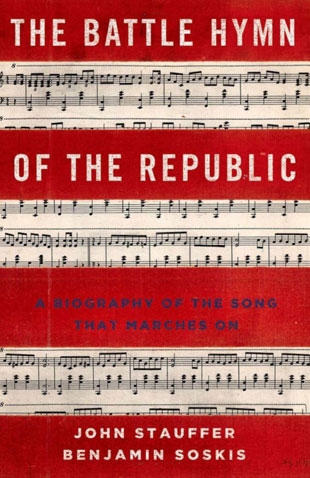John Stauffer, a historian and Benjamin Soskis, a teacher and writer, muster the energy to take us on the unpredictable and fascinating journey of this patriotic hymn whose supporters make strange bedfellows. Julia Ward Howe, an abolitionist and poet from Boston, believed that in 1861 the lyrics of "The Battle Hymn of the Republic" were sent to her by God. Ever since then, "the hymn has proven itself an exceptionally potent amalgam: a saber-rattling tearjerker."
The hymn's history stretches back long before the Civil War. In 1807 Stith Mead, a revivalist minister, put together a hymnbook which included "Say Brothers." This hymn included the words "Canaan's happy shore," which took almost polar-opposite interpretations: To slave owners, it signified "a slave society, a heavenly version of their own moral universe;" for slaves, it meant freedom.
The tune's next incarnation continued to have an ambivalent meaning. "John Brown's Body" — with its lines "John Brown's body lies mouldering in the grave / His soul's marching on" — spurred Union troops into battle, but why? Some in the North promoted an Abolitionist interpretation of the song, immortalizing John Brown's willingness to sacrifice his life for the cause of freeing slaves after gaining control of the federal armory at Harpers Ferry, West Virginia in 1859. But others found this interpretation "inconvenient, at a time when Union leaders were attempting to reassure border states that the war was being waged not to free the slaves but to preserve the Union."
Howe's hymn survived the Civil War, Reconstruction, and the Guilded Age, and it continued to be used for a wide range of causes. Theodore Roosevelt and the Progressive Party championed "Battle Hymn" as a drawing card. In the 20th century, revivalists Billy Sunday and Billy Graham made the most of the patriotism and the Christian imagery in the song. Equally in love with Howe's creation was Dr. Martin Luther King, Jr., who referred to it in letters, sermons, and rallies for civil-rights demonstrators. John F. Kennedy and Ronald Regan — two very different kinds of presidents — each had a special place in their hearts for "The Battle Hymn."
What few of these leaders, religious figures, and politicians notice or criticize is the language of warfare, battle, and combat that animates the song. One reason it has become America's unofficial anthem is that we have been at war for most of the last century. California pacifist Fanny Bixby Spencer warned in the 1920s that the hymn's popularity "had undercut America's status as a moral exemplar by celebrating the brutality we claimed to disdain in our enemies."
And yet the hymn has inspired spiritual warfare in reform movements ranging from temperance to Civil Rights, which pierce "the pall of resignation that is often as grave a threat as immoderation." The authors' conscientious and thoughtful research into the hymn's paradoxical history, along with the gripping stories they tell about key figures along the way, make this book a truly well-rounded "biography of the song that marches on."
